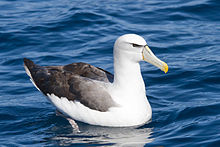| Aequornithes | |
|---|---|

| |
| Shy albatross (Thalassarche cauta) | |
|
Scientific classification
| |
| Domain: | Eukaryota |
| Kingdom: | Animalia |
| Phylum: | Chordata |
| Class: | Aves |
| Clade: | Phaethoquornithes |
| Clade: |
Aequornithes Mayr, 2010 [3] [4] |
| Clades | |
| |
Aequornithes ( /iːkwɔːrˈnɪθiːz/, from Latin aequor, expanse of water + Greek ornithes, birds), or core water birds, [6] are defined as "the least inclusive clade containing Gaviidae and Phalacrocoracidae". [3]
The monophyly of the group is currently supported by several molecular phylogenetic studies. [7] [8] [9] [10]
Aequornithes includes the clades Gaviiformes, Sphenisciformes, Procellariiformes, Ciconiiformes, Suliformes and Pelecaniformes. It does not include several unrelated groups of aquatic birds such as flamingos and grebes ( Mirandornithes), shorebirds, gulls, and auks ( Charadriiformes), or the Anseriformes(waterfowl).
Based on a whole-genome analysis of the bird orders, the kagu and sunbittern ( Eurypygiformes) and the three species of tropicbirds ( Phaethontiformes) together styled as the Eurypygimorphae are the closest sister group of the Aequornithes, [6] in a clade later named Phaethoquornithes. [11]
| Aequornithes |
| ||||||||||||||||||||||||||||||
Cladogram based on Burleigh, J.G. et al. (2015) [12] with some names after Sangster, G. & Mayr, G. (2021). [5]
References
- ^ Slack, Kerryn E.; Jones, Craig M.; Ando, Tatsuro; Harrison, G.L. "Abby"; Fordyce, R. Ewan; Arnason, Ulfur; Penny, David (2006). "Early Penguin Fossils, plus Mitochondrial Genomes, Calibrate Avian Evolution". Molecular Biology and Evolution. 23 (#6): 1144–1155. CiteSeerX 10.1.1.113.4549. doi: 10.1093/molbev/msj124. PMID 16533822. Supplementary Material Archived December 16, 2009, at the Wayback Machine
- ^ Kuhl., H.; Frankl-Vilches, C.; Bakker, A.; Mayr, G.; Nikolaus, G.; Boerno, S. T.; Klages, S.; Timmermann, B.; Gahr, M. (2020). "An unbiased molecular approach using 3'-UTRs resolves the avian family-level tree of life". Molecular Biology and Evolution. 38: 108–127. doi: 10.1093/molbev/msaa191. PMC 7783168. PMID 32781465.
- ^ a b Mayr, Gerald (2011). "Metaves, Mirandornithes, Strisores and other novelties – a critical review of the higher-level phylogeny of neornithine birds". Journal of Zoological Systematics and Evolutionary Research. 49 (1): 58–76. doi: 10.1111/j.1439-0469.2010.00586.x.
- ^ Sangster, G.; Braun, E.L.; Johansson, U.S.; Kimball, R.T.; Mayr, G.; Suh, A. (2022). "Phylogenetic definitions for 25 higher-level clade names of birds". Avian Research. 13: 100027. doi: 10.1016/j.avrs.2022.100027.
- ^ a b Sangster, G.; Mayr, G. (2021). "Feraequornithes: a name for the clade formed by Procellariiformes, Sphenisciformes, Ciconiiformes, Suliformes and Pelecaniformes (Aves)". Vertebrate Zoology. 71: 49–53. doi: 10.3897/vertebrate-zoology.71.e61728.
- ^ a b Jarvis, E.D.; et al. (12 December 2014). "Whole-genome analyses resolve early branches in the tree of life of modern birds". Science. 346 (6215): 1320–1331. Bibcode: 2014Sci...346.1320J. doi: 10.1126/science.1253451. PMC 4405904. PMID 25504713.
- ^ Hackett, S.J.; et al. (27 June 2008). "A phylogenomic study of birds reveals their evolutionary history". Science. 320 (5884): 1763–1768. Bibcode: 2008Sci...320.1763H. doi: 10.1126/science.1157704. PMID 18583609. S2CID 6472805.
- ^ Yuri, T.; et al. (2013). "Parsimony and model-based analyses of indels in avian nuclear genes reveal congruent and incongruent phylogenetic signals". Biology. 2 (1): 419–444. doi: 10.3390/biology2010419. PMC 4009869. PMID 24832669.
- ^ Kimball, R.T.; et al. (December 2013). "Identifying localized biases in large datasets: A case study using the Avian Tree of Life". Mol Phylogenet Evol. 69 (3): 1021–32. doi: 10.1016/j.ympev.2013.05.029. PMID 23791948.
- ^ Kuramoto, T.; et al. (2015). "Determining the Position of Storks on the Phylogenetic Tree of Waterbirds by Retroposon Insertion Analysis". Genome Biology and Evolution. 7 (12): 3180–3189. doi: 10.1093/gbe/evv213. PMC 4700946. PMID 26527652.
- ^ Sangster, George; Braun, Edward L.; Johansson, Ulf S.; Kimball, Rebecca T.; Mayr, Gerald; Suh, Alexander (2022). "Phylogenetic definitions for 25 higher-level clade names of birds". Avian Research. 13: 100027. doi: 10.1016/j.avrs.2022.100027. S2CID 247988800.
- ^ Burleigh, J.G.; et al. (March 2015). "Building the avian tree of life using a large-scale, sparse supermatrix". Molecular Phylogenetics and Evolution. 84: 53–63. doi: 10.1016/j.ympev.2014.12.003. PMID 25550149.
